Comics don't just grow up - they become seriously trendy
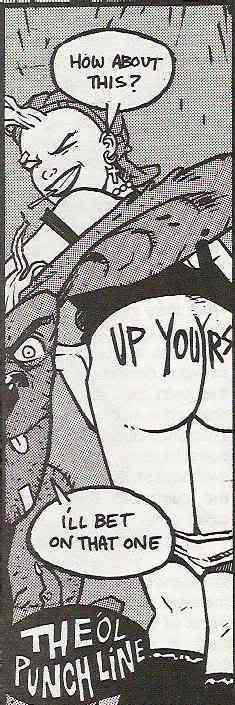
Deadline magazine isn't mentioned on the 2000 AD website. Presumably this means that it never had and never will have anything official to do with it. But, this surprisingly long-running comic (1988-1995) is surely part of the same stable whether copyright and publishing law, and perhaps even petty rivalries, will say it or not.
More confessions of a crap journalist - I've only read 3 issues of Deadline and the short Wikipedia article on it. Beyond that, I know nothing. But, I will say this: it was set up by Brett Ewins and Steve Dillon, 2000 AD greats of the 80s. Editorship was taken over at some point by Si Spencer, who went on to be one of the more regular Megazine scribes for a while. And amongst the host of artistic contributors were many who would go on to have stuff published in 2000 AD, Crisis, Toxic! and other such worthy publications. So there's a relevant pedigree - but what about the content?
I don't know what the mission statement was, but I bet it was something to do with being ultra-hip, or possibly crucial since it was 1988 after all. There seems to be a mixture of the standard 'why is there no platform for hot new artists to do their thing', and the editors wanting a magazine devoted to stuff that they happen to like, i.e. music as well as comics. To my mind, this mixture did achieve one rare thing - every issue of Deadline feels throwaway. This doesn't mean the content isn't good. It's more that I didn't feel at all inclined to bag up the issues I had, collect the missing ones, and store them for all time. And given that I collect a lot of comics, that's an achievement.
Partly it's the mixture of text stories and interviews alongside the comics. Partly it's that most of the strips themselves are not 'to be continued', even if there are plenty of recurring characters. But I think the mag is filled with a sense that this throwaway nature is what the editors wanted out of it. They wanted a fortnightly / monthly publication that people would have lying around in their student / yuppie flats, or in a hairdresser's, read bits of and discuss with their friends, then happily forget about it and be excited by the next issue, rather than obsessing over the details of early vs new stories. Which let's face it, is what a large number of comics fans like to do, and that's not the audience to pander to if you're trying to be cool.
 And the sense that people were talking about Deadline and its contents is why Deadline succeeded in this mission. It was obviously read by those people who never really got into comics, but really liked looking at those comic-inspired doodles you drew on your school file. There's some zeitgeist capturing going on right there.
And the sense that people were talking about Deadline and its contents is why Deadline succeeded in this mission. It was obviously read by those people who never really got into comics, but really liked looking at those comic-inspired doodles you drew on your school file. There's some zeitgeist capturing going on right there.Deadline may have folded, but it has a noble legacy, i.e. it introduced a whole bundle of iconic characters, launched the careers of even more great artists. But sadly it left us with nary a story to care about 15 years on. I mean, I'm sure many of you have heard of writer Alan Martin, but who can say what he's working on now? Which probably explains why I don't rate it that highly. Sure, I love an iconic picture and probably my first love for 2000 AD was inspired by Kev O'Neill, but really I'm all about the plot and the character arcs.
When I say I don't rate it, that's a subjective term. Objectively, I think Deadline is/was an awesome achievement, that really did break comics out of the niche it was in at the time and seems to be in again now. Without any stats or even memories to back me up, I believe Deadline reached that magical thing, a new audience of comics readers. You just know that Nathan Barley would have had copies in his Hoxton hole. Of course the nature of this kind of cool is inherently transitory, and since Deadline never managed to find a new Jamie Hewlett and Philip Bond to invent new characters and art styles after 5 years, it was destined to die.
Yes, Deadline as a comic was all about the art; more than out all about style over substance. Hewlett and Bond reached out to a huge number of people, and rightly so, but they weren't the only slight geniuses at work. Let's cease the prattling, and get on with the scans, eh?
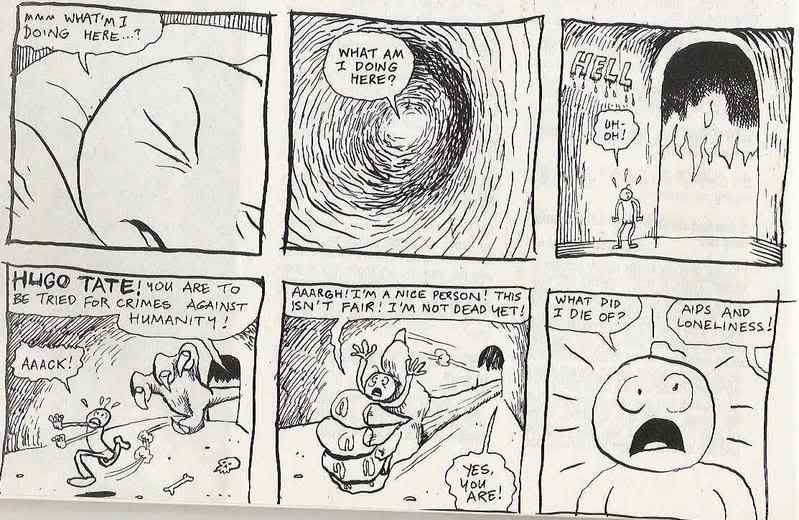 First up, my personal favourite: Nick Abadzis. He seems to have been around for years on the ultra-independent scene. I don't know if that has more to do with personal choice or lack of bigtime publishers hiring him, but he deserves to be more widely read and revered. I love his mix of wonder and cynicism. Up there with the likes of Dan Clowes as a writer/artist with mildly surreal tendencies.
First up, my personal favourite: Nick Abadzis. He seems to have been around for years on the ultra-independent scene. I don't know if that has more to do with personal choice or lack of bigtime publishers hiring him, but he deserves to be more widely read and revered. I love his mix of wonder and cynicism. Up there with the likes of Dan Clowes as a writer/artist with mildly surreal tendencies.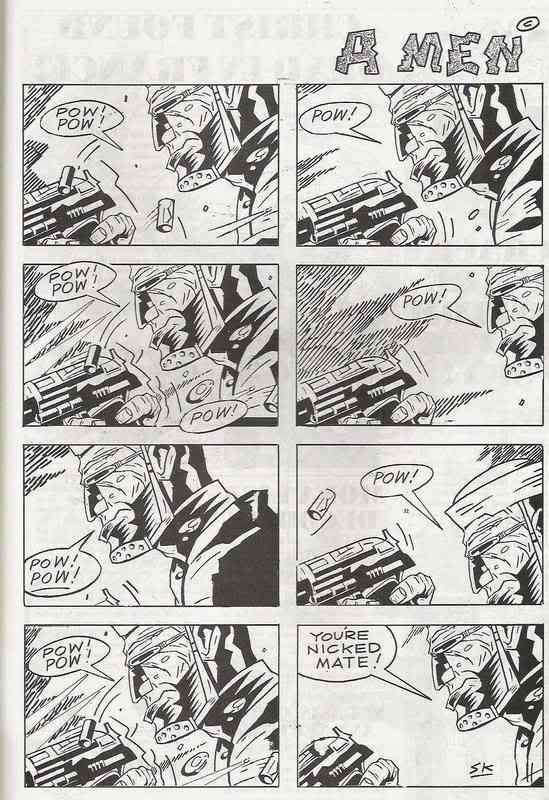 Shaky Kane. Beloved and behated of many a 2000 AD reader, I really dig his work. Like Tom Scioli on Godland, he's surely not a Kirby copier, just someone who likes that style so much that that's how he draws his comics. Sadly the ideas behind Mr Kane's comics don't always stretch that far beyond being a little bit weird. And one struggles to forgive him for his involvement with Soul Sisters. Still, being a bit weak on ideas is fair enough, and it's obviously better than I can do.
Shaky Kane. Beloved and behated of many a 2000 AD reader, I really dig his work. Like Tom Scioli on Godland, he's surely not a Kirby copier, just someone who likes that style so much that that's how he draws his comics. Sadly the ideas behind Mr Kane's comics don't always stretch that far beyond being a little bit weird. And one struggles to forgive him for his involvement with Soul Sisters. Still, being a bit weak on ideas is fair enough, and it's obviously better than I can do.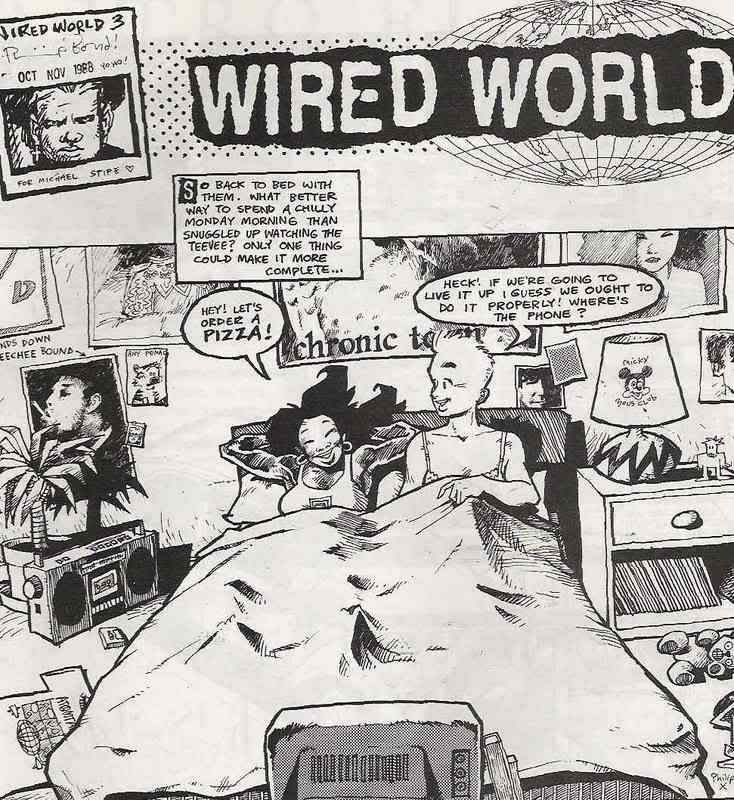
Philip Bond (yes, he is a bit like Evan Dorkin, isn't he - or is that the other way around? We'll never know). Something about Wired World is truly awesome, but the three episodes I've read weren't really all that. However, even without a satisfying story, I was launched into a conception of a certain 20something lifestyle that I always assumed I would one day be part of, but never actually was. Maybe employment conditions in Blair's 00s are just that much better than they were in Thatcher's 80s, or maybe my public school education forbids the possibility of my being in a scummy flatshare and on the dole. Who knows?
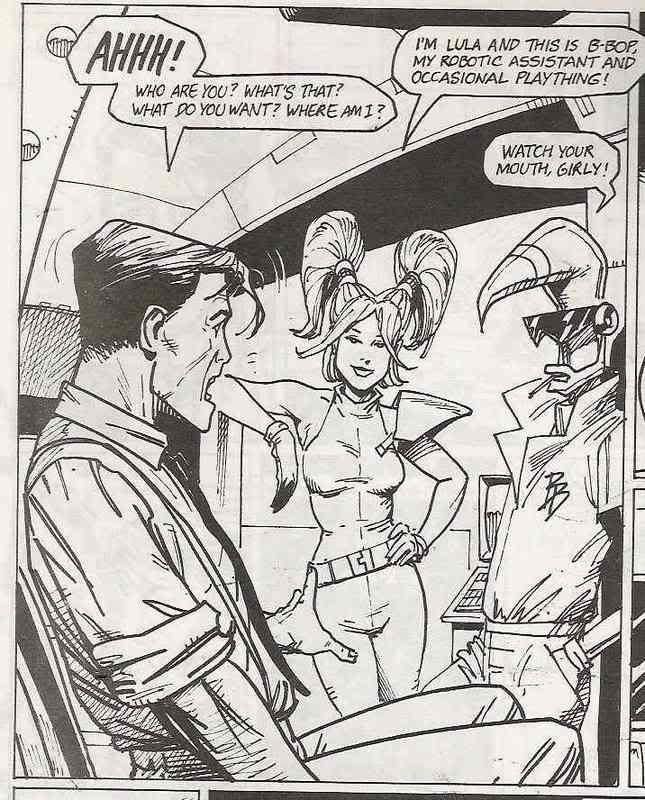 And so we come to Steve Dillon. He was no newcomer (although I expect he was still unknown in the States at this point), what with his many 2000 AD credits - some great Dredd work in particular. I get the impression that Dillon was inspired by the Halo Jones serial and wanted to work on stories a bit more like that. Whether these stories ended up in Deadline or 2000 AD seems to be a bit random. Take B-Bop and Lula form above. Was it a Tharg reject? Or just a strip Dillon knocked together in a couple of hours to fill a gap in the Deadline roster? It's in the same vein as Tyranny Rex and Hap Hazzard, after all. Fun strips all, but essentially 2000AD trendy, rather than actually trendy to the outside world. A similar problem hits that other 2000 AD stalwart, Brett Ewins. Perhaps not confident of his own writing (although quite happy to share his music taste with the world (impressively eclectic as it turns out) called in his Bad Company writing partner Pete Milligan to help. The result is Johnny Nemo:
And so we come to Steve Dillon. He was no newcomer (although I expect he was still unknown in the States at this point), what with his many 2000 AD credits - some great Dredd work in particular. I get the impression that Dillon was inspired by the Halo Jones serial and wanted to work on stories a bit more like that. Whether these stories ended up in Deadline or 2000 AD seems to be a bit random. Take B-Bop and Lula form above. Was it a Tharg reject? Or just a strip Dillon knocked together in a couple of hours to fill a gap in the Deadline roster? It's in the same vein as Tyranny Rex and Hap Hazzard, after all. Fun strips all, but essentially 2000AD trendy, rather than actually trendy to the outside world. A similar problem hits that other 2000 AD stalwart, Brett Ewins. Perhaps not confident of his own writing (although quite happy to share his music taste with the world (impressively eclectic as it turns out) called in his Bad Company writing partner Pete Milligan to help. The result is Johnny Nemo:  The most hardboiled of all detectives. I guess this strip wouldn't quite have looked right in 2000 AD of 1988, although it's pretty similar in tone to the Summer Offensive strips in 1993. Nemo is generally a funny strip, and if you like Ewins-depicted violence, I urge you to seek out one of the trades for a quick laugh. I'm a big fan of Ewins's chunky art style, but I still find it to be not as good (whatever that means) as other comics artists. Milligan, as always, is effortlessly hilarious panel to panel, but this time doesn't bother to do anything more. But then, that wouldn't fit the Deadline mission, now would it?
The most hardboiled of all detectives. I guess this strip wouldn't quite have looked right in 2000 AD of 1988, although it's pretty similar in tone to the Summer Offensive strips in 1993. Nemo is generally a funny strip, and if you like Ewins-depicted violence, I urge you to seek out one of the trades for a quick laugh. I'm a big fan of Ewins's chunky art style, but I still find it to be not as good (whatever that means) as other comics artists. Milligan, as always, is effortlessly hilarious panel to panel, but this time doesn't bother to do anything more. But then, that wouldn't fit the Deadline mission, now would it?Of course many other people contributed to Deadline, but none inspired me to write about them here. Other efforts by Bond and Hewlett are fun to look at but not great to read. You'll also notice I've barely mentioned Tank Girl, Deadline's favourite daughter. I've read a couple of Tank Girl trades. I kinda like the film. But I don't love the character, and since there are clearly many who do, it's better if you read about her and her creators from them, wherever they may be...



0 Comments:
Post a Comment
<< Home